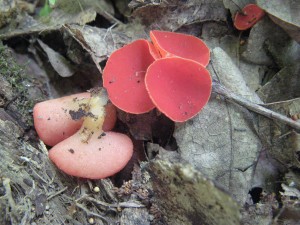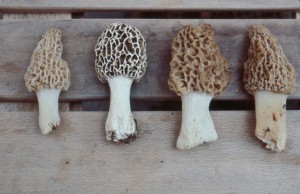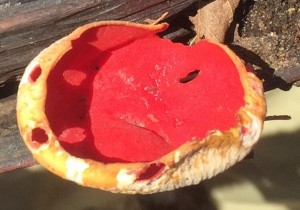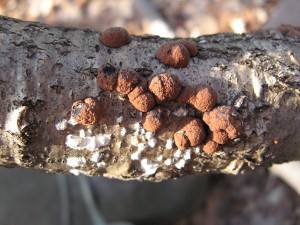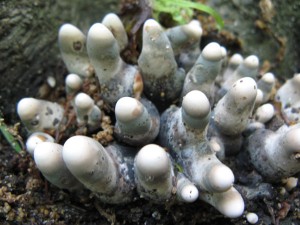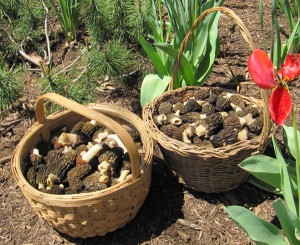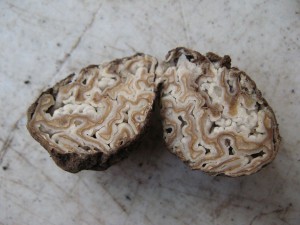ASCOMYCETES
ECOLOGY OF ASCOMYCETES
DECOMPOSERS
Aleuria aurantia (Orange Peel Cup)
ECTOMYCORRHIZAL ASCOMYCETES (Symbiotic with plants that photosynthesize)
True Truffles – Genus Tuber, and a few others
PARASITES
Cordyceps on Insects (Cordyceps spp.)
Cordyceps on False Truffles (Cordyceps spp.)
Hypomyces on mushrooms (Hypomyces lactifluorum – Lobster Mushroom = a Russula brevipes type)
CARNIVORES
Orbilia spp. – has several devices for snaring nematodes & rotifers in wood (lassoes and lethal lollipops)
ENDOPHYTES (Living inside a plant and usually helping it survive heat and drought and predators)
Lophodermium spp. (often on fallen pine needles)
EPIPHYTES
Phaeocalicium polyporaeum (growing on Trichaptum biforme, typically on or about a line of green algae – but not exchanging nutrients)
SYMBIONTS with ALGAE and CYANOBACTERIA to form LICHENS
Peltigera lichens contain a fungus and a nitrogen-fixing, photosynthetic Cyanobacterium
Almost all other Lichens associate with a Green Alga, Trebouxia, which has been found free=living in the wild.
————————————————————-
A 2016 COMA MUSHROOM UNIVERSITY spectacular find – a species of Scarlet Cup (Sarcoscypha dudleyi) – found March 19, Muscoot Farm, Westchester, NY
(Note similarity to the red cup in the photo above – That one is the summer Scarlet Cup, typically stalked (Sarcoscypha occidentalis)
————————————————————
This photo is of the 2014 COMA MUSHROOM UNIVERSITY Ascomycete Workshop
—————————————————————
There are far more ASCOMYCETES than BASIDIOMYCETES, yet very few of us are aware of more than MORELS, TRUFFLES, LOBSTER MUSHROOM, and a few cup fungi (like Sarcoscypha) or flask fungi (like Xylaria). In fact, civilization is dependent on ASCOMYCETES for our daily bread and our alcoholic beverages (YEAST FUNGI). In the form of LICHENS, ASCOMYCETES are always around us – on fence posts, on trees, on rocks, on stone walls, and on the very sidewalks we walk along. This workshop will examine our ASCOMYCETES in a variety of ways. We will look at their photographs, study specimens brought into class with hand lens and microscope, collect ASCOMYCETES in the nearby woods, and taste some of the best dishes we can make using ASCOMYCETES.
GENERA and groups of ASCOMYCETES (Ascomycota) to know…..[Note: Though confusing, the term ASCOMYCETES, a class designation, is generally used to refer to the whole phylum, the ASCOMYCOTA.]
Kingdom: Fungi
Phylum……………………………………………………..…ending: -mycota
[Subphylum…………………………….……….…ending: - mycotina]
Class…………….…………………….………ending: -mycetes
Order………………………………..ending: -ales
Family……………….…….ending: -ceae
Genus…………………..a single word with the first letter always capitalized
Species…………………a two-word name – the first word is the genus (as above), the second the species epithet, always lower case.
There are 65,000 or so species of Ascomycetes, far too many for you to learn. At least 15,000 of these are just lichens!
Let’s look at the breakdown of some of these groups of Ascomycetes.
There are 3 major Phyla of Kingdom Fungi: Ascomycota, Basidiomycota, and Zygomycota. Only the Ascomycota is being considered here.
In the Ascomycota, there are 3 Subphyla: Pezizomycotina, Saccharomycotina (yeasts), and Taphrinomycotina (a small basal group).
In the Pezizomycotina, there are a dozen or so Classes, including Dothideomycetes, Eurotiomycetes, Geoglossomycetes, Lecanomycetes (major lichens), Leotiomycetes, Orbiliomycetes, Pezizomycetes, and Sordariomycetes.
In the Pezizomycetes, there is only a single Order, Pezizales, but more than a dozen Families, and about 2000 species. In the Sordariomycetes, however, there are more than a dozen Orders, more than 60 Families, and about 10,000 species; and in the Dothideomycetes, there are more than 19,000 species.
For our purposes in this workshop, we’ll focus on 3 large classes, 3 very small classes, and a few odds and ends. The major classes we’ll study are the PEZIZOMYCETES (Operculate Discomycetes, including the cup fungi, morels, and truffles), the LEOTIOMYCETES (Inoperculate Discomycetes, including Bisporella, Chlorociboria, Leotia, Mitrula, and Powdery Mildews), and the SORDARIOMYCETES (the Flask Fungi, including Cordyceps, Hypocrea, Hypomyces, and Xylaria). Three very small, segregate classes are the GEOGLOSSOMYCETES (Geoglossum, Microglossum, and Trichoglossum), NEOLECTOMYCETES (Neolecta), and ORBILIOMYCETES (Orbilia). Two classes we’ll just touch on are the DOTHIDEOMYCETES (Apiosporina) and EUROTIOMYCETES (Aspergillus, Elaphomyces, and Penicillium). The LICHENS, because they are not all found within one class, we’ll only look at examples that are common in our area.
————————————————————————————————————-
The COMA Mushroom University ASCOMYCETE Workshop Muscoot Farm walk on Saturday, March 15, 2014 discovered more than a dozen ASCOMYCETES in what otherwise looked like a barren, still partially snow-covered woodland. We found, just noting the Ascomycetes: Daldinia concentrica, Diatrype stigma, Lasiosphaeria sp., Molissia sp., Orbilia sp. (perhaps), Kretzschmaria deusta, Nectriaceae (coral spot species), Rosellinia sp., and Xylaria longiana! The lichens we saw included Flavoparmelia caperata and a species of Parmotrema (with branched, black cilia on the ends of the lobes), and a few others on wood and rock. There are many more out there to be found now, like Apiosporina (black knot), Biscogniauxia, Hypoxylon, and the old reliable Dead Man’s Fingers, Xylaria polymorpha. Perhaps the next time. We’ll need to look at every stick and stone we pass, and every stem of every withered herbaceous plant. Ascos are everywhere – it’s up to us to find them.
————————————————————————————————————–
So, a question: What’s the point of a bump on a log?
http://www.readcube.com/articles/10.1371/journal.pone.0046687?locale=en ……….article about Hypoxylon pulicicidum as a pan-tropical insecticide-producing endophyte…..
http://www.livescience.com/20597-harnessing-plant-invading-fungi-fuel.html……..article about a Hypoxylon on Persea indica, another endophyte, containing compounds usable as fuel!
So……what’s a Hypoxylon?………….A bump on a log!
————————————————————————————
SOME WINTER ASCOMYCETES IN THE NYC-WESTCHESTER CTY. AREA…..
Apiosporina morbosa (Black Knot of Cherry)
Annulohypoxylon cohaerens
A. multiforme
A. truncatum
Ascocoryne cylichnium
Biscogniauxia atropunctata
Bisporella citrina
Bulgaria inquinans
Camarops petersii (Dog’s Nose)
Chlorociboria aeruginascens
Cryptovalsa sassafras
Daldinia concentrica (Cramp Balls)
Diatrype stigma
Diatrypella sp.
Erysiphaceae (Powdery Mildews)…on leaves
Eutypa sp.
Eutypella sp.
Godronia sp.
Hypomyces aurantius on old polypores
Hypoxylon fragiforme
H. howeianum
H. rubiginosum
Kretzschmaria (Ustulina) deusta (Carbon Cushion)
Lasiosphaeria sp.
Mollisia sp.
Nectria cinnabarina
Nectriaceae (several different from N. cinnabarina)
Phaeocalicium polyporaeum (match sticks on Trichaptum biforme)
Polycephalomyces tomentosus on slime molds
Rosellinia sp.
Xylaria liquidambar
X. longiana
X. polymorpha
In addition,
Ascomycetes are part of nearly every LICHEN in our area.
Ascomycetes are conspicuous and ubiquitous on herbaceous stems.
REFERENCES:
“Ascomycete Fungi of North America”
“Fungi of Switzerland, vol. 1: Ascomycetes”
“Pyrenomycetes of the Great Smoky Mountains National Park” (online)
“Pyrenomycetes from Southwestern France (online)
————————————————————
A few examples of ASCOMYCETES, arranged alphabetically:
ALEURIA, Pyrenemataceae, Pezizales, Pezizomycetes…..Orange Peel Cup
APIOSPORINA, Venturiaceae, Pleosporales, Dothideomycetes…..Black Knot of Cherry
ARACHNOPEZIZA, Hyaloscyphaceae, Helotiales, Leotiomycetes…..early spring orange cup fungus
ASPERGILLUS, Trichocomaceae, Eurotiales, Eurotiomycetes…..common mold on foods,like peanuts
BEAUVERIA, Clavicipitaceae, Hypocreales, Sordariomycetes…..Common insect mold
BISPORELLA, Helotiaceae, Helotiales, Leotiomycetes…..Yellow Fairy Cups
BOTRYTIS [Botryotinia], Sclerotiniaceae, Helotiales, Leotiomycetes
BULGARIA, Bulgariaceae, Helotiales, Leotiomycetes…..Black Jelly Drops
CAMAROPS, Boliniaceae, Boliniales, Sordariomycetes…..Dog Nose Fungus
CANDIDA, Saccharomycetaceae, Saccharomycetales, Saccaromycetes…..Yeast infection
CHLOROCIBORIA, Helotiaceae, Helotiales, Leotiomycetes…..Green Stain
CLAVICEPS, Clavicipitaceae, Hypocreales, Sordariomycetes…..Ergot
CORDYCEPS, Clavicipitaceae, Hypocreales, Sordariomycetes…..Caterpillar Fungus
CRYPHONECTRIA, Cryphonectriaceae, Diaporthales, Sordariomycetes…..Chestnut Blight Fungus
CUDONIA, Cudoniaceae, Helotiales, Leotiomycetes…..Dry Jelly Baby
CYTTARIA, Cyttariaceae, Cyttariales, Leotiomycetes…..Darwin’s Argentine fungus in “Voyage of the Beagle”
DALDINIA, Xylariaceae, Xylariales, Sordariomycetes…..Cramp Balls
DIATRYPE, Diatrypaceae, Xylariales, Sordariomycetes…….Shiny, black wood crust
ELAPHOCORDYCEPS, Ophiocordycipitaceae, Hypocreales, Sordariomycetes…..Truffle-finder
ELAPHOMYCES, Elaphomycetaceae, Eurotiales, Eurotiomycetes…..host of a truffle-finder
EPICHLOE, Clavicipitaceae, Hypocreales, Sordariomycetes…..common endophyte fungus in grasses
EPIDERMOPHYTON, Arthrodermataceae, Onygenales, Eurotiomycetes…..Athlete’s foot fungus
ERYSIPHACEAE, Erysiphales, Leotiomycetes…..Powdery mildews
FUSARIUM, Nectriaceae, Hypocreales, Sordariomycetes…..common plant pathogen
—————————————————————————————————-
COMPARING THE CLASSIFICATION OF THE ASCOMYCETES used in the Audubon Guide to the new “Ascomycete Fungi of North America”
Both books are selective in which Ascomycetes they include and exclude. Both exclude plant pathogens, like Chestnut Blight and Dutch Elm Disease. Both exclude Ascomycetes that cause human disease, like ringworm, and both exclude the Lichens. Both focus on the Ascomycetes large enough to be noticed in the field when people are out hunting mushrooms.
The Audubon Guide places these Ascomycetes in two Classes: the Disk Fungi (Discomycetes) and the Flask Fungi (Pyrenomycetes). The “Ascomycete Fungi of North America” disperses the “Discomycetes” into 5 Classes: the Pezizomycetes, the Leotiomycetes, the Geoglossaceae (Geoglossomycetes), the Neolectomycetes and the Orbiliomycetes. The Audubon Guide’s “Pyrenomycetes” is called the Sordariomycetes. In addition, there are a few examples from other groups that are included in the new book: the Eurotiomycetes (e.g., Onygena), the Dothideomycetes (e.g., Apiosporina and Scorias), and the Taphrinomycotina (e.g., Taphrina).
When the Audubon Guide was published (1981), the Discomycetes were understood as containing two distinctly different groups of Cup Fungi: the Operculate Discomycetes and the Inoperculate Discomycetes. The main difference is in the manner in which the ascus opens to disperse its spores, the former flips its lid, as it were, and the latter has a pore through which the spores are extruded. This is based on Fred Seaver’s “The North American Cup-Fungi.” In the Audubon Guide, the Operculate Discomycetes are those in the Order Pezizales, which includes 7 Families. The Inoperculate Discomycetes are in the Order Helotiales, distributed in 5 Families. The Audubon Guide recognizes 28 Genera in the Pezizales and 14 Genera in the Helotiales. We will study examples from these two Orders, plus the truffles, some of which are placed in their own Order, Tuberales, and others elsewhere.
The biggest difference between the two books, besides the names of the species, that always seem to be changing, is our new understanding of the Earth Tongues. In the Audubon Guide, the Family Geoglossaceae includes Trichoglossum, Microglossum, Mitrula, Neolecta, and Sphathularia, and mentions Geoglossum as a look-alike for Trichoglossum. Now, the genera Geoglossum, Trichoglossum, and Microglossum are separated out into a Class of their own: the Geoglossomycetes, and Neolecta, now recognized as a basal group (early ancestor) of Ascomycetes is also separated out into a Class of its own: the Neolectomycetes. The genera Mitrula and Spathularia are retained in the Leotiomycetes (formerly the Inoperculate Discomycetes).
In the Audubon Guide the included “Pyrenomcyetes” are placed in a single Order, the “Sphaeriales,” the Ostiole Flasks, and these are divided into 3 Families: the Clavicipitaceae (e.g., Cordyceps), the Hypocreaceae (e.g., Hypocrea and Hypomyces), and the Xylariaceae (e.g., Daldinia, Hypoxylon, Ustulina [now Kretzschmaria], and Xylaria). The “Ascomycete Fungi of North America” includes more examples.
Most of the Families and Genera recognized in the Audubon Guide are retained in the “Ascomycete Fungi of North America.” Mostly, though, only the names of the species have been changed to protect the innocent. (a paraphrase of a line from the 50’s TV show, ‘Dragnet’)
———————————————————————————————–
A SHORT SET OF REFERENCES ON ASCOMYCETES:
Beug, Michael, and A.E. and A.R. Bessette. “Ascomycete Fungi of North America”
Breitenbach, J. and F. Kranzlin. “Fungi of Switzerland, vol. 1: Ascomycetes”
Brodo, I.M, and S.D. and S. Sharnoff. “Lichens of North America”
Also, see the website: ‘Lichens of North America’
http://comafungi.org/learn/photos/ascomycota/
Kendrick, Bryce. “The Fifth Kingdom”
http://www.mycolog.com/CHAP4b.htm
Kuo, Michael. “Morels”
Lincoff, G.H. “The Audubon Society Field Guide to North American Mushrooms”
Seaver, Fred, J. “The North American Cup-Fungi”
MYKOWEB.com – Click on “Systematics,” then “Mycological Literature,” and scroll down to see copies of Seaver’s books (see above ref.)
and don’t forget to check the COMA FACEBOOK PAGE – I have now put up over 60 species of ASCOMYCETES, one a day.
For a KEY to MORELS, see this website page labelled ”COMA U: MUSHROOM UNIVERSITY 2012″
Website for Xylariaceae: http://mycology.sinica.edu.tw/xylariaceae/default.asp


